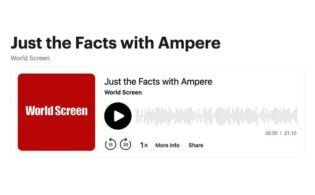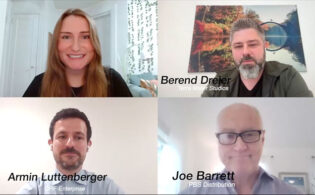Fred Black, principal analyst at Ampere Analysis, showcased how unscripted content has fared over the last two years and looked at the challenges for the sector on the final day of the TV Real Festival.
Black leads Ampere’s Commissioning service, which tracks the commissioning and production of new original content globally. His keynote session can be viewed here.
Eroding pay-TV and ad revenues and slowing subscription revenues have caused “major upheaval in the content marketplace,” Black said. “Over the past few years, streamers have been paying a very high price for their subscriber acquisition, both through the costs involved in rapid international expansion and also the high cost of their own original content. Now we’re entering this period of reducing costs. It’s fairly natural that these platforms are reducing their commissions. Extra income is also being sought through lower-priced advertising tiers on their SVOD services. Particularly at the studios, we’re seeing them re-embrace licensing their content to third parties.”
Black then took a deep dive into how present market conditions are impacting unscripted in particular. Entertainment, reality and docs saw a decline in commissions last year, as all genres did, “but that fall wasn’t as dramatic as the rise we saw in 2022.”
Black added, “In 2020 and 2021, scripted commissions outweighed documentary commissions in six of the eight quarters. In the eight quarters since the start of 2022, scripted commissions have actually only exceeded documentary commissions once. Reality commissions, meanwhile, are about level now with the number of scripted commissions. As these platforms start to cut back and look for more cost-effective ways to make content, unscripted’s relative importance to the industry is on the rise even if we’re seeing commission volumes start to stall.”
Spotlighting the documentary genre, Black explained that commissions in Western Europe remain relatively high but were down 17 percent in North America and 30 percent in Asia. “The key reason for this discrepancy is the stability offered by the strong public broadcasting tradition in Europe. Public broadcasters commissioned half of documentaries in Western Europe, compared to only 10 percent in North America; they really are the key to the region’s stability. AsiaPac has a more similar profile to Western Europe, but the decline we’ve seen in documentaries there recently has been led particularly by commercial free-to-air groups and also reflects relatively weak public broadcasters in Australia and New Zealand.”
It’s a similar story for reality content, Black said, with Western Europe and Asia relatively stable but North America down 16 percent. “Again, the difference here is related to the profile of who is making reality content. In Europe and Asia, free-to-air channels dominate, while in the U.S. and North America, it’s the cable channels and the SVOD services. They have been cutting back extensively over the last couple of years.”
Drilling down further into the doc slates of platforms globally, for public broadcasters, the top three themes are arts and culture, travel, and nature and animals. “But there are also significant slates of historical, biographical, political and science documentaries in here as well,” Black said. At pay-TV and SVOD services, meanwhile, “crime documentaries are emerging as the dominant force. They make up a full 25 percent of documentary commissions at the pay TV channels and the SVODs.” Black added that 45 percent of documentary commissions at the SVODs are either true crime or sports-themed.
Pubcasters continue to have fairly diverse doc slates overall, Black said, “but we are starting to see some clear strategic changes. In particular, public broadcasters are starting to focus on some of the themes that we might more typically associate with streaming services. In particular, true-crime content is really starting to creep up the leaderboard. It’s risen from the seventh most popular theme to the fourth most popular in just a year. That has come at the cost of some of the public broadcasters’ more traditional topics; things like arts and culture, historical, scientific and political documentaries were all in decline in the previous year. This strategy has two obvious advantages for the public broadcasters. Firstly, most are somewhere along the journey towards streaming-first business models, and they need to attract viewers to these new video-on-demand platforms. True crime has proven to be a very reliable, bingeable streaming hit elsewhere. Secondly, at a time when almost all public broadcasters are being threatened with cuts to their funding, they need to start making content with greater resale value. That’s an easy way to make up for funding shortfalls. These crime and thriller commissions are not only for the benefit of their own video-on-demand platforms, they also have one eye on future distribution to other video-on-demand platforms as well.”
It’s similar at the commercial free-to-airs, Black continued. “True crime is the area where commissions are being maintained as everything else starts to be cut back. We’re also seeing travel documentaries start to go slightly out of vogue. Pay-TV channels also cut back heavily, with around 150 fewer commissions last year. But again, the focus here is on crime and thriller. It was already the most popular theme, but it cemented its place in 2023. In fact, it was the only theme where the number of commissions from pay-TV channels rose last year compared to the previous one. Cutbacks particularly fell on travel documentaries.”
At the SVODs, “it’s really all about true crime and sports content. These two genres both grew their share significantly. The two of them together now make up a full 50 percent of SVOD documentary commissions over the last 12 months. What did change significantly here, however, is the volume of documentary content being ordered. There are pretty severe cutbacks for documentary commissions, down 23 percent year on year on a global basis. Not only are the SVODs making less of their own documentary content, they are reducing the amount of documentary content they are looking to acquire for their libraries as well. All of the major platforms added significantly less documentary content to their libraries in the previous year than in the last two years, and at discovery+ and Disney+, the amount of acquired documentary content being added to the platform is now less than the amount being removed. So these documentary libraries are shrinking. The opportunity to sell into them is falling.”
The only area that is growing for the SVODs is true crime, Black added. “Everywhere other than Disney+ added at least 100 hours of acquired true crime content last year. Amazon remains a fairly fertile selling ground for biographical, sports, historical and travel content sold by third parties. But at most of the other streamers, we’re beginning to see a bit of a zero-sum game where they’re interested in acquiring true crime content but not much else. So while the documentary sector overall remains fairly strong, the threatened funding for public broadcasters and the difficult linear ad market means commissioners are increasingly making their decisions with one eye on streaming distribution, and that means that the shrinking scope and scale of what streamers want in terms of documentary is a particular problem for us; it is going to reduce the diversity of documentary output over the longer term.”
Black then explored the reality genre, where “the only area where commissions have been maintained is with public broadcasters. All of our commercial players are reducing the number of reality commissions they’re making. That fall has come over the longer term from pay-TV and SVOD platforms. At the commercial free-to-air channels, we’ve really only started to see that take effect in Q1 this year. Q1 is normally the peak for commercial free-to-air reality commissions. It didn’t happen in 2024.”
For Black, the key trend in reality is around new versus returning brands. “Commissioners are continuing to renew their established content while avoiding the risk of new reality shows. While that is a risk-averse strategy in the short term, in the long term, it starts to risk stagnation. We’ve seen the average age of a reality commission from around 4.5 [seasons] in the middle of 2022 to 6.2 in Q1 this year. Broadcasters are sticking to established titles, even if they only prove middlingly successful, rather than taking a risk on something new. That creates this lack of space for new ideas and innovation. If that trend is allowed to continue, it’s likely to lead to audience fatigue. That will lead to a further decline, and that’s a phenomenon that we may already be starting to see close in on the commercial free-to-air channels.”
Focusing in on the format export business in Western Europe, Black explained, “Back in 2021 and 2022, for every two formats that got renewed, it was likely that one format got the chance to launch itself in a brand-new market. Over the last year, year and a half, we see that start to change. That figure has moved first to around three renewals per new series launched.” In Q1, it was up to five renewals for every new IP commissioned, Black said.
 TVREAL
TVREAL






